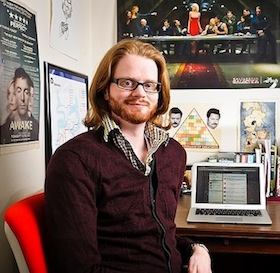Five Questions: Lecturer, critic McNutt connects TV viewing and social media

Myles McNutt, lecturer in communication arts, works in his office in Vilas Hall.
Photo: Bryce Richter
Watching and discussing television — its production, social impact and sense of place — has given Myles McNutt a unique perspective on the American experience. Through social media, McNutt, now a University of Wisconsin–Madison doctoral candidate, has found the perfect intersection between research and real life.
During the past academic year, McNutt navigated cultural and industry conventions as a lecturer for Comm Arts 351, Introduction to Television. His own spin on this long-running class (now led by Assistant Professor Derek Johnson) is to let students use social media to provide opportunities for interaction and additional detail.
As an online critic for the Onion’s AV Club, McNutt presides over all levels of discourse — some profound, others less so. He has built relationships with people like “Scrubs” producer Bill Lawrence, who “crashed” one of the Comm Arts 351 connected screenings to virtually interact with students.
McNutt spoke with Inside UW–Madison about how he uses social media in his teaching and research.
Inside UW: How did you get started with social media?
McNutt: It’s a really gradual process. You don’t always start social media for a purpose; you start because you’re bored. In a class, I thought a blog would help me say, “I’m on the cutting edge.” I never thought, “I’m doing this to network.”
But I started blogging about TV because I was passionate about it, and my worlds started converging. What I do online fuels my passion for teaching and research. I’m lucky enough that what I talk about on social media is connected with what I teach. I want there to be a relationship between those things; I’m terrified of those things seeming separate.
As I researched Ph.D. programs, I saw Twitter as a valuable opportunity to chime in. Coming from Canada, I didn’t have access to conferences or a lot of academic communities, but I had that access over Twitter: following hashtags and participating in discourse. I think that’s a huge part of why I’m here; I had that opportunity to connect with the Comm Arts program from 4,000 miles away.
Inside UW: How do you view social media as a teaching tool?
McNutt: Twitter is a space in which we might engage on a casual or social level. But it’s also where we’re expected to engage with TV directly. The industry is moving in that direction: putting hashtags on the screen; having actors tweet from media events.
Bringing that to students gets them thinking about how their relationship with television extends into other platforms. It gives them a sense of how Twitter is engaged with the industry, and expectations for how it’s being used. They have the opportunity to not simply discuss, but also shape how we view the TV industry.
We introduced our connected screenings, saying, “We know you might use Twitter to talk about TV. Let’s take the screening period, have you use your phones and computers. Let’s put you up on the hashtag, put the hashtag up on the screen, and engage with this text in a particular way.” Students get more detail, and a more engaging or interactive experience.
Inside UW: Where do you find similarities between teaching and criticism?
McNutt: To me, the real conversation takes place in the comment sections. Some of the pedagogy we use has to extend itself into that environment.
As a critic, I’m responding two hours after I’ve seen something. My opinion is the first of what will hopefully become 50 comments, where people will embrace and express a dialogue. Other people have a day to think about it, and they’ll post incredibly insightful comments.
It’s the same as spending time in discussion when I’m teaching, or in office hours. All of those are spaces in which initial statements can be expanded upon and made better.
Many people think, “Comment sections are a mess.” They can be. I shape that in whatever way I can. If someone comes in with a completely deconstructed comment, I’ll often push back: “Can you expand on this?” Sometimes I’ll get really thoughtful responses. Instead of feeding the trolls, you kind of teach them how to eat.
Inside UW: What’s your guilty TV pleasure?
McNutt: I don’t want to be guilty about any of it. I want my students to feel safe in sharing what they’re watching. Growing up, I watched a lot of professional wrestling. I’ve had to reveal that to my students; I say, “I know you don’t believe me, but wrestling is important, too.”
So I say, “What’s a show that you might not list as your favorite but still enjoy?” … None of us will have the exact same opinions. Both critically and in terms of teaching, guilt is something I don’t want to express. I think we need to own that.
Inside UW: What do you hope your students take away — from your class and your social media use?
McNutt: What connects me with Bill Lawrence, or anyone on Twitter, is often just a desire to talk about TV. I wanted to sell that to my students by bringing in Bill, saying, “He’s actually a person.” On one level, it’s such a coincidental series of events; but on another, it’s natural.
That potential is what fuels media attention. The TV industry banks on that. … Ask my students who wants to be in the industry, and 2/3 of the hands go up.
If they end up in that position, maybe they’ll retain whatever we’re trying to teach them about issues of diversity in the workforce, or labor and cultural hierarchies. We can’t make TV, but we can hopefully educate those who will.




